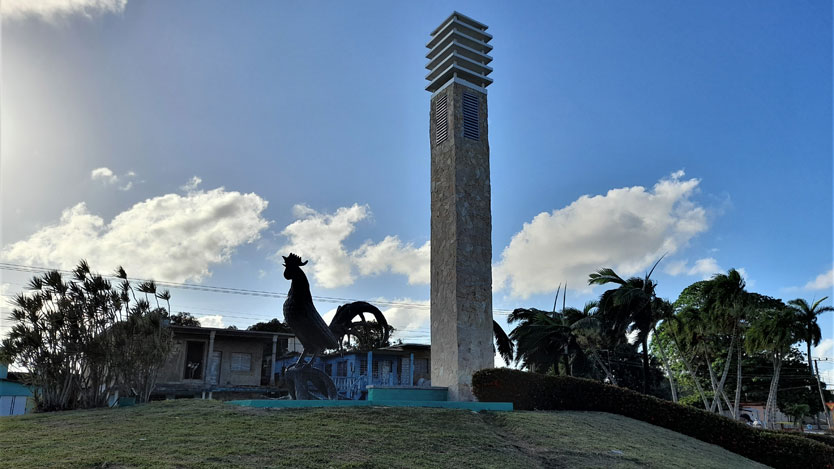
Days ago, talking about the restoration of Morón Rooster was common, but not always in the same "direction". Some did not believe it was possible and others trusted with their eyes closed that the symbol of the municipality would regain its splendor.
That it was possible is the evidence in the vigorous song at dawn and in the afternoon, although it was first on the night of last May 1, waiting for a new anniversary, already freshly renovated. We are not breaking the news now. That is what social networks are for, some would say. However, we are valuing what has been done in the face of the complexity of the work, the deterioration, the height, the rain or the wind.
In September of last year, Invasor had announced the start of repairs to the sculptural complex, made up of the tower and the sculpture signed by Rita Longa. We must thank the positive hurry to Deputy Prime Minister Jorge Luis Tapia Fonseca, who, during a tour in August, regarding the confrontation with CIVID-19, said "the Rooster has to sing again."
Financed by the local dependency of the Ciego de Ávila Community Services Company (Comcávila) and executed by the Military Construction Union, the work went through different stages, according to what was published by the Cuban News Agency.
Ineldo Borrero Sarría, civil engineer and head of the UCM Unit Area, explained that the first thing was to carry out a technical study that allowed corroborating the constructive state of the monument, from which leaks were diagnosed in the basement cover slab and deterioration in the upper and lower parts of the tower, with cracks and exposed steel that could cause a subsequent collapse.
The comprehensive repair of the sculptural ensemble also included the complete lifting of the grass (grass that surrounds the sculpture), which is on a concrete surface that serves as a roof for the basement.
With a budget of 200,000 pesos, the self-employed workers of Laredo's Constructions, led by Ariel García Galindo, also took part in the work. They managed to repair the tower and put a floor around it. The work was not easy, as the structure, visibly deteriorated, showed cracks that required a much deeper repair.
The final result had the input of many. The windows of the tower were changed and this action fell to the ALUDEN Company of Ciego de Ávila; the dome was made with plycem fiber cement technology, mounted on an aluminum structure; In addition, the electrical installation for the lights was added, which was something that it did not have. The Cuban Telecommunications Company (ETECSA) in the municipality was responsible for rescheduling the reproduction of the rooster's song in the city.
"We worked on a variant made by the UCM, which contemplated plating the tower with slabs and its original design was rescued, which was made by the architect Hernando Hernández Prado, who designed the dome," García Galindo explained.
Currently, the people of Moron are witnessing the return of the rooster's song, which is reproduced at 6:00 in the morning and again at 6:00 in the afternoon, with three repetitions.
Origins of the sculptural ensemble
Historiography connects the Morón Rooster, in Ciego de Ávila, with the famous Morón de la Frontera Rooster, a city in Andalusia, Spain. There are two versions of the latter, which is why we will not take sides here.
The truth is that, in the mid-1950s, two enthusiasts from Moron, Augusto Venegas Muíñas and Benito Llanes Recino, proposed and promoted the idea of erecting a monument to the Rooster. The opportunity to concretize the idiosyncrasy and culture of the city in a symbol quickly caught on in the town, while the politicians of that time saw a chance to campaign.
Thus, on September 11, 1955, the very President of the Republic, Fulgencio Batista Zaldívar, inaugurated the sculpture. This almost fortuitous link would mean that, at the triumph of the Revolution, the rooster would be uprooted from its place, to be replaced by the people of Morón days later, and again dismantled and destroyed on February 12, 1960. The rooster, as a symbol, was became taboo.
Twenty years passed before the subject was brought up again. It was Larry Morales, at the request of Celia Sánchez, who delved into the history of the territory and concluded that the popular roots of the sculpture had nothing to do with politics. They caressed again, then, the idea.
The Ecured Collaborative Encyclopedia collects that, in the Eighth Ordinary Session of the Second Period of Mandate of the Municipal Assembly of People's Power in Morón, held on March 1, 1981, and at the proposal of the delegate José Manuel Hernández, the agreement No.114, which approved the creation of a commission for the replacement of the Morón Rooster.
The bronze bird was placed back on its pedestal on May 2, 1982 by a team of artists made up of Rita Longa, the Architect Manuel González Suárez and the author of the first rooster, the sculptor Armando Alonso.
